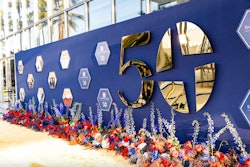![Pag 4571[3]](https://img.bizbash.com/files/base/bizbash/bzb/image/2024/06/PAG_4571_3_.665f33fa2b275.png?auto=format%2Ccompress&q=70&w=400)
 Amanda MaPhoto: Courtesy of Amanda Ma
Amanda MaPhoto: Courtesy of Amanda Ma
For event planners, marketing teams, and communications leaders, the upcoming summer provides the rare opportunity to take a breath and truly plan for large fall and winter activations. With the gift of time comes the opportunity to ensure that a flawless, bespoke experience is delivered not just at the event itself, but in all pre- and post-event touchpoints as well.
For many teams, anniversary celebrations are the most pressure-filled to be perfect. Whether it’s the attendance and expectations of senior leaders or the fact that milestones are celebrated just once, these events are the ones that most often lead to stress and tension. This is where having an outside party can support.
For many clients, internal teams responsible for event execution might have only worked on a handful of large-scale celebrations in their careers. However, our team at the Anniversary Collective has executed hundreds of events. We bring these best practices to every new engagement, and thanks to that experience, we've seen where common pitfalls in planning can occur.
While event design is still in its early stages, there is an ample window to create something that will have attendees and other VIPs talking well after the event is over. Bearing this in mind, here are a few of the most common things we see in this period, and the strategies the Anniversary Collective has developed to mitigate.
1. Overlooking diverse stakeholder interests
When serving a wide range of stakeholders, including investors, employees, and partners, planning a celebration that does not adequately consider or engage all these diverse groups is a major pitfall. Each of these groups needs to “see” themselves in the event to feel that, in the end, it was a success.Mitigation strategy
During initial phone calls and planning sessions, identify and gather input from all available stakeholder groups, including what their expectations for the event are—from concept ideation to post-event follow-up. This feedback informs the planning process, ensuring the celebration is inclusive and resonates during all stages.2. Failing to communicate company history and culture
An anniversary project should reflect the company’s historical and recent contributions to the financial well-being of its clients and the broader impact it has made on the world. Many companies use an event to talk about the next chapter, and in doing so, miss creating real emotional touchpoints regarding the stories that led to this key moment.Mitigation strategy
Through historical and social listening research, develop messaging that highlights a company’s achievements, innovations, and contributions to its industry. Use storytelling across various platforms to communicate this impact both effectively and fulsomely.3. Neglecting digital engagement
While we always care about creating a beautiful room and in-person experience, failing to leverage digital platforms for an anniversary celebration limits its reach and engagement, especially given the global nature of today’s business world and the digital savvy of many stakeholder groups. With many companies utilizing hybrid or remote workers, as well as consultants, ensuring a digital component means the event reach and ROI can expand exponentially.Mitigation strategy
Developing a comprehensive integrated strategy that includes social media, email campaigns, a dedicated anniversary webpage, and virtual event components will engage a wider audience. Ensuring the use of multimedia, interactive widgets, and other tools means you can bring these stakeholders “into” the event meaningfully as well.4. Discovery of previously unknown caches of archives and preservation issues
Companies with long histories that have experienced expansion, mergers, and diversification have distributed archives that lack centralized management and understanding. Many times, these materials show signs of neglect or have been held in poor storage conditions, resulting in mold, media obsolescence, and more. However, these can be powerful storytelling tools and there are a variety of technological ways to clean or otherwise restore them for use.Mitigation strategy
Our discovery process uncovers these unknown sources right away through surveys and conversations. We can then engage our deep partnership network of specialists beyond the Anniversary Collective to help restore these items and return them to use not just in the physical realm (such as an interactive display) but in a digitized way that can allow them to be used online, by other teams in the organization, and more.5. Establishing clear objectives
When planning an event, teams tend to think through the tactical approaches—the food, the decor, or the interactive elements, just to name a few. Rarely do they take time to clearly define nontangibles—the way they want people to feel, the ambiance to be achieved, or the actions they want people to take in the days following an event. These are just as important as pitch-perfect keynotes and tasty hors d’oeuvres.Mitigation strategy
In the earliest planning stages, teams need to write down the largest goals and objectives of the project. Understanding what you want to achieve at the most macro levels—such as increasing brand visibility, boosting employee morale, or strengthening relationships with stakeholders—is key for designing an event that will echo in time.6. Allocate and obtain sufficient resources
Events and anniversary celebrations usually fall to internal teams that already have very full plates. When you throw in a sizable milestone, it can be the equivalent of adding a full-time job to a full-time job. It’s critical that in the planning stages, the team adequately allocates budget, manpower, and other resources to support the anniversary project.Mitigation strategy
Hiring outside teams is not another line-item cost; it’s a budget saver. Having an outside team frees up internal resources to keep daily projects in motion and focus more strongly on those tasks that are best managed in-house such as collateral creation, technological requirements gathering, and obtaining additional personnel for event support.7. Making employees engaged
Involving employees in the planning and execution process fosters a sense of ownership and commitment that might not exist if they are coming in blindly, especially when an event is global or national in nature. When employees feel they had input into how something looks or feels, they tend to have a better time participating.Mitigation strategy
Working with local leaders and HR teams can help secure the advice and gather input on what would make a celebration resonate. For example, tailoring collateral to be culturally relevant, creating unique leave-behinds, or ensuring food has a local twist are all simple ways to make employees feel heard and bring them into the celebration.



















